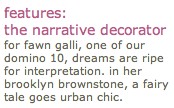Medical student Clinton Pong, who blogs at Not My Second Opinion writes:
I love stories. One of the things I feel so lucky about as a student doctor is my opportunity to hear the stories of my patients! They give me with small snippets of their lives, bits and pieces that I scribble down onto their character sheets. Then I report to the attending physician and get my experience points in the form of teaching topics. My life may not have a Dungeon Master guiding me along on a quest to rescue a damsel in distress, but I do feel glad that I get the opportunity to play a hero sometimes 🙂
He reminds me of a nice academic journal piece (in the journal Explore) by Victor Sierpina, Mary Jo Krietzer, Elizabeth MacKenzie, and Michelle Sierpina. The piece, about narrative medicine, looks at “coconstruct[ing] with the patient the reality of the medical encounter and the tone and timbre of the healing relationship.”
More lovely snippets from the article:
“… in medicine the quantitative is never the whole story. … It is in narrative that we rediscover our humanity. … narrative medicine uses reflective writing to evoke empathy.”
The article talks about courses that teach “the use of personal illness narratives to ensure that the humanity of both provider and patient remains central in the clinical encounter.” Writing medical narratives, the authors write, helps medical students ask themselves, “What did I learn from that? Why do I believe what I do? What do I think about this?”
“Why is narrative an effective antidote to isolation, callousness, and numbness?” the authors ask. “Because it serves as a lifeline to experiencing our own humanity, as well as a bridge that connects us with others, breaking through barriers built by professional roles, judgments, biases, assumptions, stress, and time pressures.”
Physicians, the authors assert, need “the ability to listen to the narratives of the patient, grasp and honor their meaning, and be moved to act on the patient’s behalf. This is narrative competence, that is, the competence that human beings need to absorb, interpret, and respond to stories.”
 Storytelling continues to emerge in academic research about organizational life.
Storytelling continues to emerge in academic research about organizational life.



 Limor of
Limor of